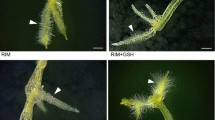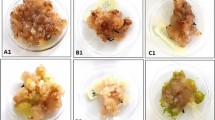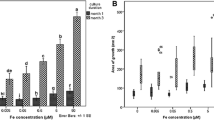Abstract
Callus was obtained from hypocotyls of Mesembryanthemum crystallinum seedlings cultured on two types of medium—germination medium (GM) and callus induction medium (CIM). Following subculture on shoot induction medium SIM1, the callus formed on CIM medium regenerated roots or somatic embryos, while that obtained on GM medium was non-regenerative. The activities of CuZn-superoxidase dismutase (SOD) were comparable in all calli, but the activities of FeSOD and MnSOD varied according to the activity of photosystem II and the regenerative potential of the tissues. Catalase (CAT) activity was related to H2O2 concentration and affected by both the culture conditions and the morphogenic potential of the calli. The possible role of CAT, SODs and H2O2 in the regeneration of M. crystallinum from callus is discussed.





Similar content being viewed by others
Explore related subjects
Discover the latest articles and news from researchers in related subjects, suggested using machine learning.Abbreviations
- BAP:
-
6-Benzylaminopurine
- BSA:
-
Bovine serum albumin
- CAM:
-
Crassulacean acid metabolism
- CAT:
-
Catalase [EC 1.11.1.6]
- DTT:
-
Dithiotreitol
- 2,4-D:
-
2,4-Dichlorophenoxyacetic acid
- EDTA:
-
Ethylenediaminetetraacetic acid
- F m :
-
Maximum chlorophyll a fluorescence
- F 0 :
-
Minimum chlorophyll a fluorescence
- Fv/Fm:
-
Maximum photochemical efficiency of photosystem II (Fv, the difference between Fm and F0)
- NAA:
-
α-Naphthaleneacetic acid
- NBT:
-
Nitro blue tetrazolium salt
- PAGE:
-
Polyacrylamide gel electrophoresis
- PEG:
-
Polyethylene glycol
- RH:
-
Relative humidity
- ROS:
-
Reactive oxygen species
- SOD:
-
Superoxide dismutase [EC 1.15.1.1]
- TEMED:
-
N,N,N′,N-tetramethylethylenediamine
- Tricine:
-
N-Tris[hydroxymethyl]methylglycine
References
Adams P, Nelson DE, Yamada S, Chmara, Jensen WG, Bohnert JH, Griffiths H (1998) Growth and development of Mesembryanthemum crystallinum (Aizoaceae). New Phytopathol 138:171–190
Aebi H (1984) Catalase in vitro. Methods Enzymol 105:121–126
Alsher RG, Erturk N, Heath L (2002) Role of superoxide dismutases (SODs) in controlling oxidative stress in plants. J Exp Bot 53:1331–1341
Bagnoli F, Capuana M, Racchi ML (1998) Developmental changes of catalase and superoxide dismutase in zygotic and somatic embryos of horse chestnut. Aust J Plant Physiol 25:909–913
Beauchamp C, Fridovich I (1971) Superoxide dismutase: improved assays and an assay applicable to acrylamide gels. Anal Biochem 44:276–287
Benson E, Lynch PT, Jones J (1992) Variation in free-radical damage in rice cell suspensions with different embryogenic potentials. Planta 188:296–305
Bohnert HJ, Cushman JC (2001) The ice plant cometh: lesson in abiotic stress tolerance. J Plant Growth Regul 19:334–346
Bradford MM (1976) A rapid and sensitive method for quantitation of microgram quantities of protein utilizing the principle of protein-dye binding. Anal Biochem 72:248–254
Brennan T, Frenkel C (1977) Involvement of hydrogen peroxide in the regulation of senescence in pear. Plant Physiol 59:411–416
Claire DA, Ngoc Duong M, Darr D, Archibald F, Fridovich I (1984) Effects of molecular oxygen on detection of superoxide radical with nitroblue tetrazolium and on activity stains for catalase. Anal Biochem 140:532–537
Cui K, Xing G, Liu X, Xing G, Wang Y (1999) Effect of hydrogen peroxide on somatic embryogenesis of Lycium barbarum L. Plant Sci 146:9–16
Cushman JC, Bohnert HJ (2000) Genomic approaches to plant stress tolerance. Curr Opin Plant Biol 3:117–124
Cushman JC, Wulan T, Kuscuoglu N, Spatz MD (2000) Efficient plant regeneration of Mesembryanthemum crystallinum via somatic embryogenesis. Plant Cell Rep 19:459–463
Dat J, Vandenabeele S, Vranova E, van Montagu M, Inzè D, van Breusegem F (2000) Dual action of the active oxygen species during plant stress responses. Cell Mol Life Sci 57:779–795
Desikan R, Mackerness RS-H, Hancock JT, Neill SJ (2001) Regulation of the Arabidopsis transcriptome by oxidative stress. Plant Physiol 127:159–172
Halliwell B (1997) Free radicals and human disease-trick or treat?. In: Thomas CE, Kalyanaraman B (eds) Oxygen radicals and the disease process. Harwood Academic, Switzerland, pp 1–15
Inzè D, van Montagu M (1995) Oxidative stress in plants. Curr Opin Biotechnol 6:153–158
Konieczny R, Czaplicki A, Golczyk H, Przywara L (2003) Two pathways of plant regeneration in wheat anther culture. Plant Cell Tissue Org Cult 73:177–187
Laemmli UK (1970) Cleavage of structural proteins during assembly of the head of bacteriophage T4. Nature 227:680–685
Libik M, Pater B, Elliot S, Ślesak I, Miszalski Z (2004) Malate accumulation in different organs of Mesembryanthemum crystallinum L. following age-dependent or salinity-triggered CAM metabolism. Z Naturforsch 59c:223–228
Lüttge U (1993) The role of crassulacean acid metabolism (CAM) in adaptation of plants to salinity. New Phytopathol 125:59–71
Marco A de, Roubelakis-Angelakis KA (1996a) The complexity of enzymic control of hydrogen peroxide concentration may affect the regeneration potential of plant protoplasts. Plant Physiol 110:137–145
Marco A de, Roubelakis-Angelakis KA (1996b) Hydrogen peroxide plays a bivalent role in the regeneration of protoplasts. J Plant Physiol 149:109–114
Meiners MS, Thomas JC, Bohnert HJ, Cushman JC (1991) Regeneration of multiple shoots and plants from Mesembryanthemum crystallinum. Plant Cell Rep 9:563–566
Miszalski Z, Ślesak I, Niewiadomska E, Bączek-Kwinta R, Lüttge U, Ratajczak R (1998) Subcellular localization and stress responses of superoxide dismutase isoforms from leaves in the C3-CAM intermediate halophyte Mesembryanthemum crystallinum L. Plant Cell Environ 21:169–179
Mittler R (2002) Oxidative stress, antioxidants and stress tolerance. Trends Plant Sci 7:405–410
Murashige T, Skoog F (1962) A revised medium for rapid growth and bioassays with tobacco tissue cultures. Physiol Plant 15:473–497
Neill SJ, Desikan R, Clarke A, Hurst RD, Hancock JT (2002) Hydrogen peroxide and nitric oxide as signalling molecules in plants. J Exp Bot 53:1237–1247
Papadakis AI, Roubelakis-Angelakis KA (2002) Is oxidative stress responsible for plant protoplast recalcitrance? Plant Physiol Biochem 40:549–559
Papadakis AI, Siminis CI, Roubelakis-Angelakis KA (1999) Generation of active oxygen species in tobacco and grapevine protoplasts. Plant Physiol 121:197–205
Papadakis AI, Siminis CI, Roubelakis-Angelakis KA (2001) Reduced antioxidant machinery correlates with suppression of totipotency in plant protoplasts. Plant Physiol 126:434–444
Pinheiro da Costa S, Soares A, Arnholdt-Shmitt B (2001) Studies on induction embryogenic globular structures in Opuntia ficus-indica. J Prof Assoc Cactus Dev 4:66–74
Racchi ML, Bagnoli F, Balla I, Danti S (2001) Differential activity of catalase and superoxide dismutase in seedlings and in vitro micropropagated oak (Quercus robur L.). Plant Cell Rep 20:169–174
Rossum MWPC, Alberda M, van der Plas LHW (1997) Role of oxidative damage in tulip bulb scale micropropagation. Plant Sci 130:207–216
Scandalios JG, Guan L, Polidoros AN (1997) Catalase in plants: gene structure, properties, regulation and expression. In: Scandalios JG (ed) Oxidative stress and molecular biology of antioxidant defenses. Cold Spring Harbor Laboratory Press, Cold Spring Harbor, pp 343–406
Siminis CI, Kanellis AK, Roubelakis-Angelakis KA (1994) Catalase is differentially expressed in dividing and nondividing protoplasts. Plant Physiol 105:1375–1383
Ślesak I, Miszalski Z (2003) Superoxide dismutase-like protein from roots of the intermediate C3-CAM plant Mesembryanthemum crystallinum L. in in vitro culture. Plant Sci 164:497–505
Ślesak I, Karpinska B, Surówka E, Miszalski Z, Karpinski S (2003a) Redox changes in the chloroplast and hydrogen peroxide are essential for regulation of C3-CAM transition and photooxidative stress responses in the facultative CAM plant Mesembryanthemum crystallinum L. Plant Cell Physiol 44:573–581
Ślesak I, Libik M, Miszalski Z (2003b) Superoxide dismutase activity in callus from the C3-CAM intermediate plant Mesembryanthemum crystallinum L. Plant Cell Tissue Org Cult 75:49–55
Thorpe TA (1980) Organogenesis in vitro: structural, physiological and biochemical aspects. Int Rev Cytol Suppl 112A:71–111
Vranová E, Inzé D, van Bergusegem F (2002) Signal transduction during oxidative stress, J Exp Bot 53:1227–1236
Wang B, Lüttge U (1994) Induction and subculture of callus and regeneration of fertile plants of Mesembryanthemum crystallinum L. Pol J Environ Stud 3:55–57
Woodbury W, Spencer AK, Stahman MA (1971) An improved procedure using ferricyanide for detecting catalase isozymes. Anal Biochem 44:301–305
Yen HE, Zhang D, Lin J-H, Edwards GE, Ku MSB (1997) Salt-induced changes in protein composition in light-grown callus of Mesembryanthemum crystallinum. Physiol Plant 101:526–532
Acknowledgements
This study was partly supported by Polish KBN grants 6P04C 00320, 6P04F 03420, 3P04C06423 and EU grant QoL-2001-Integr to the Institute of Plant Physiology Polish Academy of Science and Deutsche Forschungsanstalt für Luft-und Raumfahrt (DLR). The Deutsche Akademische Austauschdienst (DAAD) provided the growth chamber.
Author information
Authors and Affiliations
Corresponding author
Additional information
Communicated by H. Lörz
This work is dedicated to Prof. Dr. Hubert Ziegler on his 80th birthday.
Rights and permissions
About this article
Cite this article
Libik, M., Konieczny, R., Pater, B. et al. Differences in the activities of some antioxidant enzymes and in H2O2 content during rhizogenesis and somatic embryogenesis in callus cultures of the ice plant. Plant Cell Rep 23, 834–841 (2005). https://doi.org/10.1007/s00299-004-0886-8
Received:
Revised:
Accepted:
Published:
Issue Date:
DOI: https://doi.org/10.1007/s00299-004-0886-8




